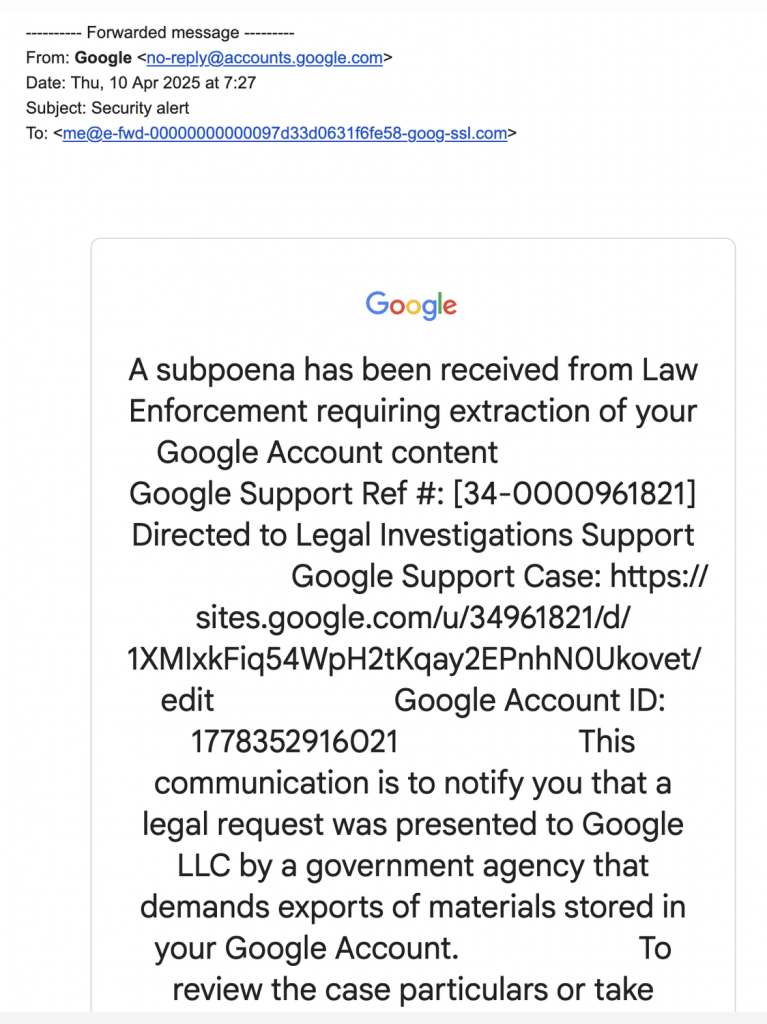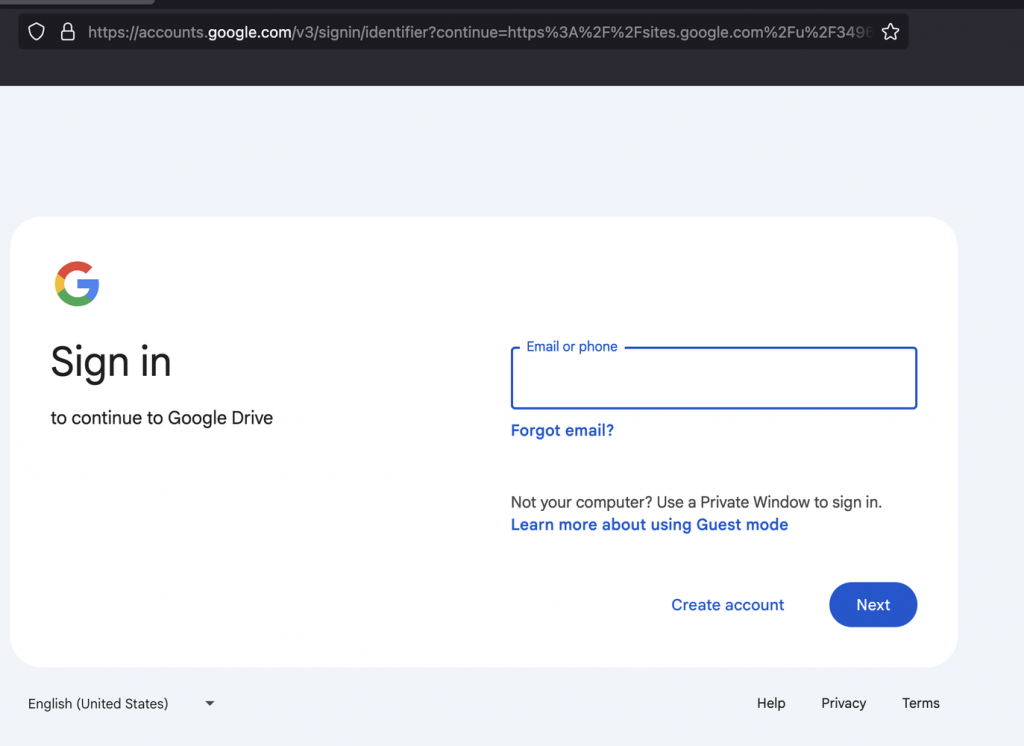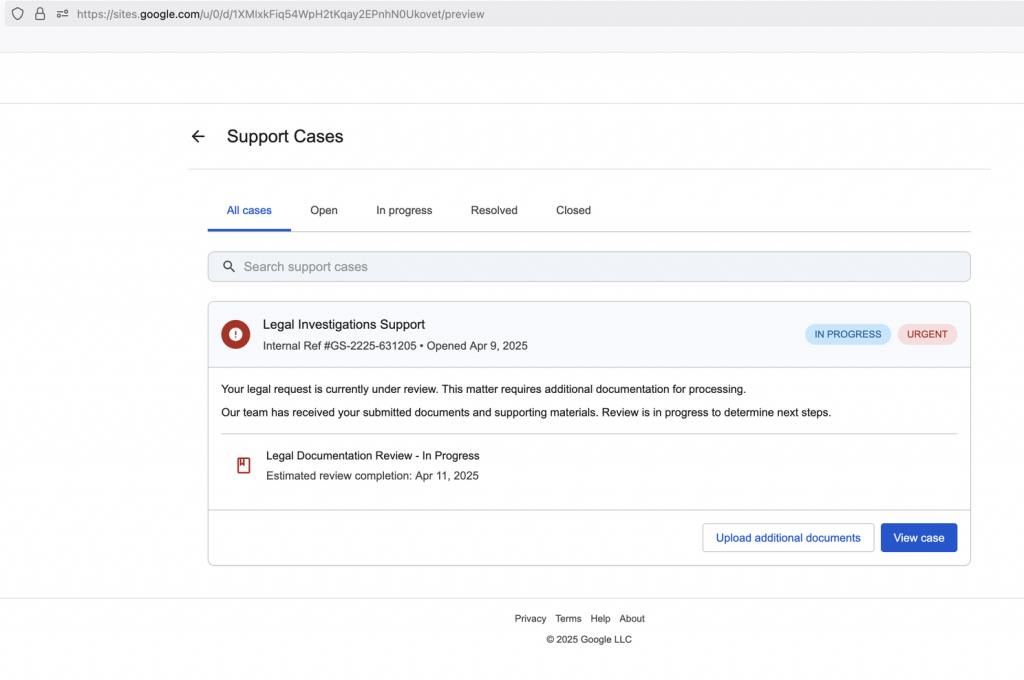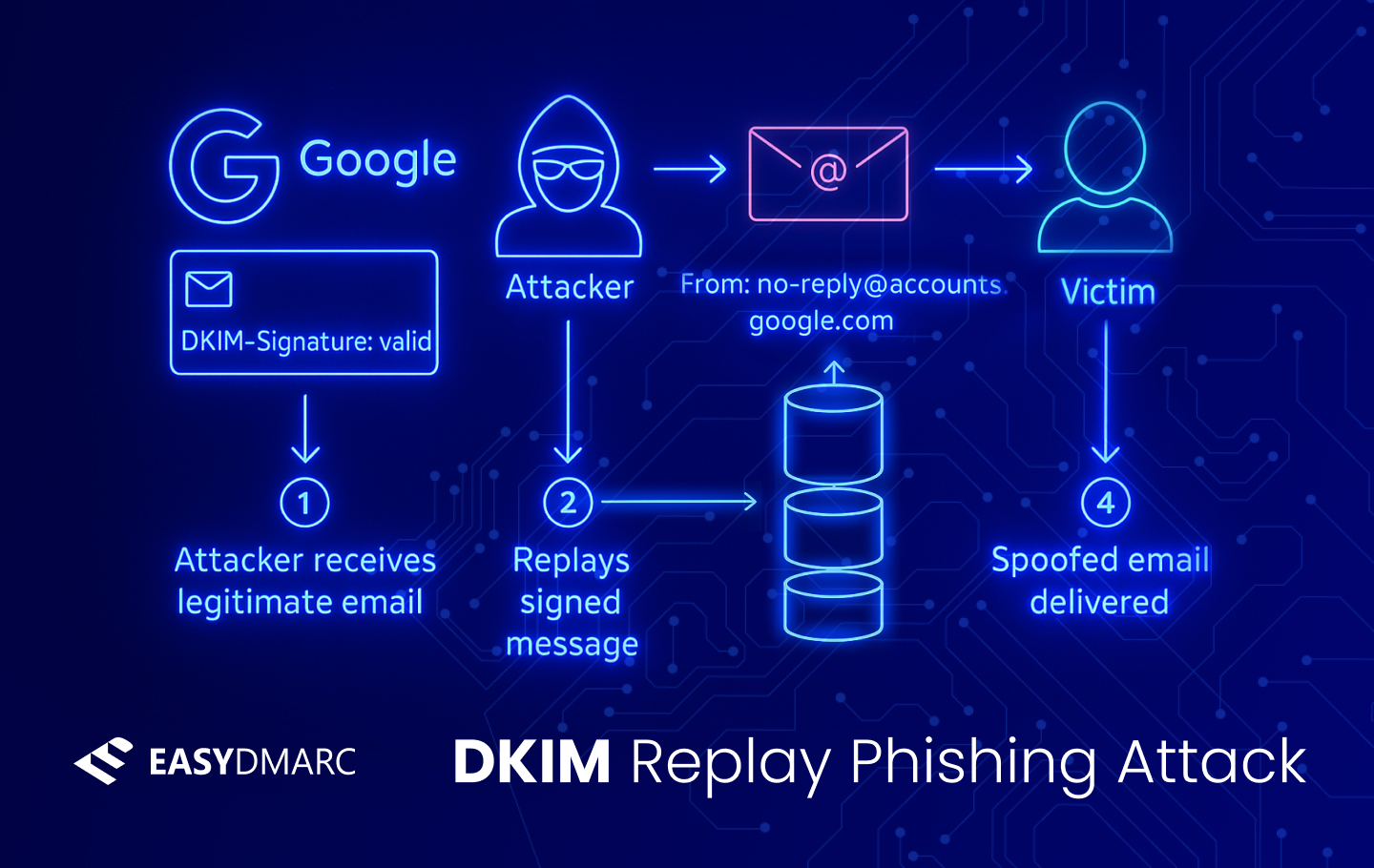This morning started with a call from a friend – clearly shaken. He had just received an alarming email that looked strikingly legitimate. Unsure whether it was safe or a scam, he reached out to me for help verifying its authenticity.
What followed was a deep dive into the message to determine whether it was a genuine communication or a cleverly crafted phishing attempt. The email was convincing enough to create real concern, and that’s what makes this story worth sharing.
This was the email:

The email claimed that a subpoena had been issued by law enforcement requesting the extraction (access/download) of the contents of his Google Account.
What made the situation even more alarming was that the email appeared to come from a legitimate Google no-reply address. On the surface, everything looked clean – no typos, no odd links, and the sender domain seemed genuine. But something felt off, and that gut feeling is often your first line of defense.
Thank you for your submission.
Your report has been successfully sent
to name email.
Digging Deeper: Investigating the Suspicious Email
Curious and concerned, I examined the email headers and link previews in a sandbox environment, a secure setup isolated from production systems, specifically designed for this kind of research. On the surface, everything appeared to check out:
- The sender address looked like an official Google no-reply domain
- The branding and language were polished and professional
- There were no obvious grammar issues or suspicious attachments.
But as we know, phishing campaigns have gotten much more sophisticated. So, I dug into the email headers, checking the SPF, DKIM, and DMARC authentication results. That’s when the red flags began to appear.
Important Reminder: Don’t Engage with Suspicious Emails
Never click on links or follow instructions in suspicious emails, no matter how legitimate they may seem. Even opening a link or downloading a file could trigger malicious scripts or redirect you to phishing sites designed to steal your credentials.
If you’re unsure, leave the investigation to professionals who can safely analyze the message in a sandboxed environment..
Interacting with a malicious email outside of such an environment could result in:
- Loss of sensitive data
- Business Email Compromise (BEC)
- Account takeovers
- Wider network breaches
When in doubt, don’t click – report and escalate.
Here is the URL from that email:
https://sites.google.com/u/34961821/d/1XMIxkFiq54WpH2tKqay2EPnhN0Ukovet/edit
This redirects to the Google account login page if you are not logged in :

After logging in, or if you are already logged in, it sends you to the Google Sites page.

Here’s something critically important to understand: This is not a real Google support page. It’s not a Google sign-in page. It’s not any official Google property in the traditional sense.
Instead, it’s a regular Google Sites page, a free tool anyone can use to build a website. In this case, cybercriminals used it to create a page that mimics an official Google support case, complete with convincing visuals and language.
Because it’s hosted on a trusted google.com subdomain (like sites.google.com), many users let their guard down. But don’t be fooled – just because the domain looks legitimate doesn’t mean the content is.
What Google Sites Is Used For
Google Sites serves as a practical tool for various purposes, including:
- Internal team pages (like company intranets or project dashboards)
- Documentation hubs
- Event landing pages
- Personal portfolios or school projects
- Simple public websites
You can create a site by dragging and dropping content blocks (text, images, videos, Google Docs, etc.), and it’s tightly integrated with other Google Workspace tools.
When Trusted Infrastructure Becomes a Threat: Google Sites Abuse
Google Sites, originally launched in 2008, is part of Google Workspace and allows any authenticated user to create a custom website hosted under the sites.google.com domain. It’s widely used for internal and public-facing content due to its ease of use, zero cost, and native integration with Google products.
However, that same convenience is now being weaponized by attackers.
Why it’s dangerous:
- Anyone with a Google account can create a site that looks legitimate and is hosted under a trusted Google-owned domain.
- There’s no need for custom hosting or domain registration, and attackers benefit from Google’s SSL certificates and brand reputation.
- Attackers can embed deceptive content (fake login screens, credential harvesting forms, misleading CTAs) under a domain that would normally pass casual user trust and even automated link validation checks.
Now let’s take a closer look at the key elements that make this scam so deceptive.
How the Attacker Performed a DKIM Replay to Spoof Google
This attack was a confirmed DKIM Replay Attack where a spoofed message appeared to be from [email protected], had passed DKIM and DMARC, and was delivered to a Gmail inbox.
Below is a step-by-step explanation of exactly what the attacker did, from start to finish — including all infrastructure involved.
Step 1: Attacker receives a legitimate email from Google
The attacker first received a real email from Google, originating from [email protected].
It included a valid DKIM signature:
DKIM-Signature: d=accounts.google.com; s=20230601; bh=a+1bch/…
The attacker then extracted and saved this exact email, including headers and body, without modifying anything signed by DKIM.


Step 2: Attacker prepares to replay the signed message
DKIM (DomainKeys Identified Mail) works by applying a digital signature to specific headers and the body of the email when it is first sent. This signature is generated using the sender’s private key and is attached as a header in the email itself.
When the message is forwarded, the original DKIM signature usually remains untouched as long as the email content and headers covered by the signature are not modified. Since forwarding services often preserve the original message as-is (especially in cases like aliasing or server-side forwarding), the DKIM signature remains valid and can still be verified using the sender’s public DNS record.
dkim=pass
Step 3: Attacker sends the email from Outlook
The attacker used an Outlook account ([email protected]) to send the spoofed message.
Outbound hop:
Server: LO3P265CU004.outbound.protection.outlook.com
IP: 40.93.67.3
In another example, the origin of the email is Google’s notification service. The email flow is described in the attack reproduction section at the end of this article.
Step 4: Message is relayed through Jellyfish SMTP
Microsoft then hands the message over to a custom SMTP service:
Relay: asp-relay-pe.jellyfish.systems
IP: 162.255.118.7
This system acts as a middle relay, distancing the spoof even further from Google. It’s not affiliated with Namecheap or PrivateEmail.
Step 5: Message forwarded via Namecheap’s PrivateEmail
The message is then received by Namecheap’s mail infrastructure (PrivateEmail), which provides mail forwarding:
Systems involved:
- mta-02.privateemail.com
- DIR-08
- fwd-04.fwd.privateemail.com
- fwd-04-1.fwd.privateemail.com
During this phase:
- A new DKIM signature is added: DKIM-Signature: d=fwd.privateemail.com; l=52331;
- The body beyond 52KB is not signed, but this DKIM is not aligned, so it’s not used for DMARC.
- SPF passes due to rewritten Return-Path, but is also not aligned.
However, since the original Google DKIM is untouched and aligned, DMARC still passes.
Step 6: Final delivery to Gmail
Final delivery is handled by:
Sender: fwd-04-1.fwd.privateemail.com (66.29.159.58)
Recipient MX: mx.google.com
At this point, the email reaches the victim’s inbox looking like a valid message from Google, and all authentication checks show as passing:
- SPF=pass (via forwarder)
- DKIM=pass (from Google)
- DMARC=pass (based on aligned DKIM)
Final SMTP Hop Breakdown:

When a Fake Subpoena Becomes an Attack Vector
Fake subpoena emails are especially dangerous because they trigger fear, urgency, and confusion. Most people don’t know precisely how subpoenas work, so when an email looks official and mentions legal action, it’s easy to panic and click without thinking.
To clarify, a subpoena is typically issued by:
- A court
- A lawyer (in civil cases)
- A government agency (in administrative cases)
A subpoena can require someone to:
- Appear in court
- Provide documents or evidence
- Testify at a deposition or trial
Serving a Subpoena
The subpoena must be formally served to the person or entity. Common methods include:
Personal Service (most common and preferred)
- A process server or law enforcement officer physically hands the subpoena to the individual.
- Required in most cases to ensure proper delivery and acknowledgment.
Mail or Email (only in some cases)
- Some jurisdictions or situations (especially civil subpoenas) allow service by certified mail or email, but only with prior consent or court approval. In such cases, the subpoena should be delivered in an encrypted way using the company’s official email address. It’s never delivered through third-party platforms.
A Registered Agent (for companies)
- If the subpoena is for a business, it’s often served to their registered agent (a person or service officially designated to receive legal documents on the company’s behalf).
Knowing how real subpoenas are issued and delivered can help you spot red flags. Phishing threats are evolving, no longer marked by broken English and sketchy URLs. Today’s attacks often come cloaked in legitimacy, sometimes even using platforms like Google Sites to mimic real support cases. As we saw in this real-world example, even the most tech-savvy users can be caught off guard.
The Takeaway?
Always question unexpected emails, especially those urging urgent action or containing links to login pages. Just because something looks like it comes from Google (or any other trusted source) doesn’t mean it’s safe.
When in doubt, don’t click, don’t reply, and don’t engage. Escalate to your security team or a professional who can handle the investigation in a secure, sandboxed environment.
I’m interested in seeing more real-life examples. Do you have any notable cases to share?
We Have an Update: Reproducing the Attack
We have dived deeper and successfully reproduced the attack:
In the first step, the attacker registered a domain via Namecheap. We observed the attack originating from the following domains, which have now been taken down:
googl-mail-smtp-out-198-142-125-38-prod.netwd-00000000000097d33d0631f6fe58-goog-ssl.com
On the second step attacker registered a free PrivateEmail via Namecheap.
me@googl-mail-smtp-out-198-142-125-38-prod.net
On the third step they registered a Google Workspace account (free trial) and verified the domain via the DNS TXT record. You need to register it in the google to be able to move to the next steps.
In the next step, they created a Google OAuth app and granted the access to that account.
Here’s the twist: Google sends the alert or notification to the privately registered email address, where the domain is verified but uses different MX records than Google’s (specifically, Namecheap PrivateEmail).
And most importantly, the key trick is that you can put anything you want in the App Name field in Google.:

The alert goes directly to the Namecheap account, which has some very interesting “capabilities.”.
You can create conditions and put no-reply@google account as From address and the reply address can be anything:

the forwarding rule will direct the email to the desired addresses:

It is clearly visible from Resent-From and Redirected-From headers:

Here is the result:

The other details have already described.
Frequently Asked Questions
What is a DKIM replay attack?
A DKIM replay attack is when an attacker captures a legitimate email with a valid DKIM signature and re-sends (replays) it to new victims. Since the body and signed headers remain unmodified, the DKIM signature still validates, making the spoofed email appear authentic.
Can SPF or DMARC prevent DKIM replay attacks?
Not reliably.
1. SPF validates the MAIL FROM domain and sending IP, which often won’t align during a replay.
2. DMARC relies on alignment between SPF or DKIM and the Header From. If DKIM is aligned (as in this case, google.com), and still valid, DMARC can pass, even though the message is replayed from an attacker’s server.
Why are DKIM replay attacks hard to detect?
DKIM replay attacks are hard to detect because the message appears unmodified, with a valid DKIM signature and even a DMARC pass.
If you rely on the email body or DKIM signature verification you may not see anything suspicious. The attack relies on trust in previously signed content, not on breaking cryptography.
How did the attacker bypass detection using Google OAuth?
The attacker created a malicious Google OAuth app, naming it something like “Google Support.”
They inserted phishing content and links into the App Information which includes manually cloned Google support page hosted on sites.google.com.
Google generated a valid security alert from [email protected] when access was granted, which the attacker then forwarded to the victim.
The forwarded email looked like it came from Google and passed DKIM/DMARC, giving it credibility.
What are the most effective ways to be cautious and reduce the risk of DKIM replay attacks?
Rotate DKIM Keys Frequently
Changing your DKIM keys regularly reduces the time window attackers have to abuse a captured signed message. Set your rotation cycle to 30 days or less for high-risk domains.
Raise User Awareness
Users play a critical role in detecting suspicious activity:
1. Encourage caution when clicking on links, even if the sender looks familiar.
2. Remind users to check URLs carefully before entering any credentials.
3. Share examples of phishing tactics like urgent language, fake legal notices, or account alerts.
4. Promote a culture of reporting. If something feels off, it’s always worth flagging.



Can Authenticated Receive Chain (ARC) mitigate this attack vector? You don’t say where the recipient mail is hosted or provide full de-identified headers of the phish. IIRC google will silently drop forwarded google.com and gmail.com without ARC headers.
Hey Ryan,
ARC will not mitigate this attack vector, since the core issue lies in how the attacker generates the phishing email directly from Google itself. They manipulate the App Name to include phishing content and links, then receive that legitimate email and relay it to other users.
The attack doesn’t involve forwarding in the traditional sense—it’s not a third-party mail flow issue where ARC could help preserve authentication. It starts as a valid email from Google.
That’s great and a very detailed digital forensics effort!
But other than “don’t click on suspicious links” and “be more suspicious about email for this type of communication”, what can be done to thwart this type of phishing scam??
There are many steps and and hops to this nefarious procedure, so surely there can be some tightening of the obvious loopholes.
Lewis, appreciate the comment.
You’re right – this goes beyond just telling users to be cautious. The issue is that the phishing email is generated by Google, with attacker-controlled content injected via the App Name. It passes SPF, DKIM, and DMARC, so standard filters don’t catch it.
As you mentioned, the message passes through multiple hops — but that’s kinda “common” in normal mail flow. Relays, auto-forwards, and platform processing often add hops. For example, Microsoft alone will route a message through 4 internal servers before final delivery. So counting on hop count isn’t a reliable signal for detection either.
The real fix has to come from Google tightening how app-generated emails are built and what content is allowed. They’ve already taken some measures, but there are still open gaps.
Nice detailed write up and thanks for sharing this.
I was wondering what is the fix for this and who should be doing it? Is this new kind of attack?
Is there no timestamp to check replay attack or am I missing something here. For me it is bit hard to understand this attack really hard to detect even for security professionals (not in email security domain) including me.
Cheers,
Tahseen
Thanks.
Thanks Tahseen, great questions.
This attack abused both DKIM and how Google handled OAuth app names. The attacker reused a DKIM-signed email originally sent through a legitimate ESP, but the key trick was in how they set the OAuth app name. Instead of a normal app name like “Drive” or “Docs”, they set it as a full paragraph that included malicious links. Since Google used to include the app name inside their confirmation emails, the phishing content appeared as part of the message, coming directly from Google. This made the email look completely legitimate and bypass traditional filters.
There’s no timestamp or recipient check in DKIM, so the email can be replayed anytime. A good indicator of a replayed message is the hops in the email headers. If the message passes through multiple MTAs before reaching the recipient—especially if the sending IP doesn’t match the original ESP – it’s very likely a replay attack. The bottom-most “Received” line will usually reveal this.
Google has since fixed the issue by limiting what can be used as an app name, so attackers can’t inject content like this anymore.
Has Google acknowledged this problem? Are they fixing it? Is anyone else in the chain working to stop it?
Yes, Google has addressed the main issue related to injecting content through the App Name field. However, there are still other gaps that can potentially be exploited for similar abuse. We may publish those findings as well.
Exemplary analysis – a model for other technical writers to follow. But also scary… thanks for the warning.
Thanks, Tom!